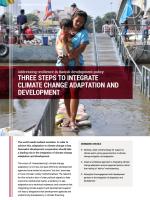Three steps to integrate climate change adaptation and development
The world needs resilient societies. In order to achieve this, adaptation to climate change is key. Denmark’s development cooperation should take a leading role in the integration of climate change adaptation and development.
■ Develop a clear overall strategy for support to climate action, giving equal attention to climate change mitigation and adaptation
■ Adopt an ambitious approach to integrating climate change adaptation across supported sectors, rather than relying on “add-on” mainstreaming
■ Strengthen the engagement with development partners in the integration of adaptation and development
The notion of “mainstreaming” climate change adaptation is not new, but past efforts by development agencies have tended to become “tick-box” exercises or have not been widely institutionalised. The reasons for this include a lack of clear political signals to help overcome institutional inertia, a tendency to see adaptation as a technical subsector, and concerns that integrating climate support and development support will lead to allegations that development agencies are undermining transparency in climate financing.
Recently, however, there has been a growing recognition among many actors, including multilateral organisations, of the close relationship between climate change adaptation and development. This provides an opportunity for a concerted push to integrate adaptation with development efforts. Denmark should pursue a high-profile role in this respect. Three overall steps can help achieve this:
■ There is a need for an overall strategy to steer Denmark’s support to action on climate change in developing countries. The strategy should make climate change a key aim of Danish development cooperation, alongside poverty alleviation and other core issues.
■ The strategy should focus equally on mitigation and adaptation. Although mitigation support is obviously critical, it is becoming increasingly clear that the world will most likely move beyond both the 1.5- and 2-degree goals. Adaptation efforts must be expanded if the SDGs are to be achieved.
■ The strategy should build on and develop Denmark’s existing mainstreaming guidelines, including the Guiding Principles for the Danish Climate Envelope. It should clearly emphasize an integrated approach to adaptation both within and outside the Climate Envelope.
■ Adaptation is currently integrated into some of the more obvious bilateral programmes, such as those supporting water and agriculture, and there have been efforts recently in other sectors. However, there is a need for a consistent approach and integration of climate change adaptation across the portfolio. In the wake of the Covid 19 crisis, health will become an obvious area for such integration. Other areas include private-sector support, employment, peace, migration and governance.
■ A greater emphasis on systemic thinking is required. For example, support to agriculture, water and infrastructure could be complemented with a stronger focus on integrating adaptation into ecosystem- and resource management, including links to the parallel biodiversity crisis.
■ In order to avoid climate change adaptation becoming a mere “add-on” and tick-box exercise, it must be incorporated into programming from the outset by means of an early and clear analysis of how support will address climate risks and associated vulnerability. This will also help demonstrate the climate aspect of support, and thereby transparency. Approaches to do so are available.
■ There should be a strong emphasis on the governance dimension, i.e. ensuring inclusive decision-making on adaptation as it becomes integrated into and is implemented in public planning across society, including an emphasis on the principle of subsidiarity.
■ There is a need to increase the focus on partner countries’ own Nationally Determined Contributions (NDCs) to the Paris Climate Agreement and their associated national climate and development policies. In some cases national policies are now quite integrated, and here the need is for support to implementation.
■ Denmark has an opportunity to learn from and seek greater influence on the growing emphasis on adaptation in organisations such as the World Bank and UNDP. Denmark should also focus more on advocating integrated approaches to adaptation and development in the Green Climate Fund and the NDC Partnership.
This DIIS Impact has received financial support from the Ministry of Foreign Affairs of Denmark. It reflects the views of the authors alone.
DIIS Experts





